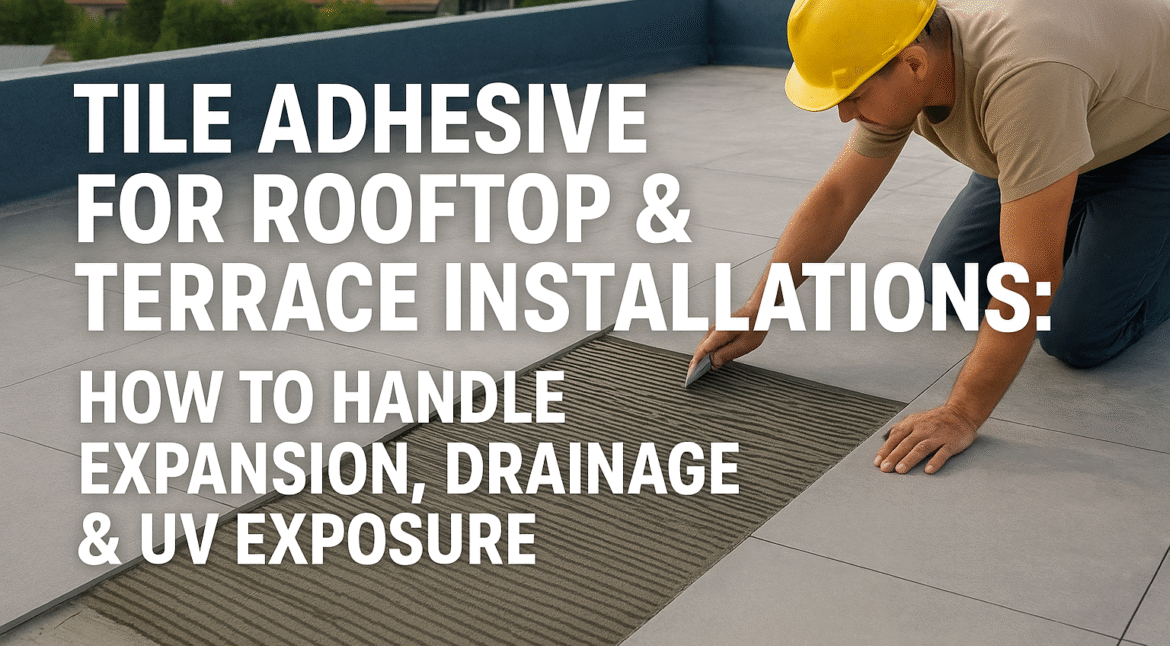Tile Adhesive for Rooftop & Terrace Installations: How to Handle Expansion, Drainage & UV Exposure
Rooftop and terrace areas are among the most challenging surfaces in construction — extreme heat during the day, cool temperatures at night, continuous UV exposure, and frequent wetting from rain. These cycles of expansion, contraction, and moisture make it crucial to choose the right tile adhesive that can perform under stress. Using a standard indoor adhesive in such an environment often leads to tile debonding, cracks, and leakage, which can compromise the structure and aesthetics.
Common Question Asked:
Q.1 Can normal tile adhesive be used for terrace or rooftop installations?
No, indoor-grade adhesives are not formulated to handle outdoor temperature fluctuations, UV radiation, or prolonged water exposure. You need flexible, waterproof, and UV-resistant tile adhesives designed for external applications.
Why Rooftop and Terrace Areas Need Specialized Tile Adhesives
Unlike indoor floors, terraces and rooftops experience large temperature variations that cause the surface to expand and contract. Without a flexible adhesive, these movements can push tiles apart or cause cracks. Additionally, poor drainage or water stagnation on flat terraces creates hydrostatic pressure beneath the tiles — a major cause of debonding.
High-quality waterproof tile adhesives are formulated to counter these issues. They contain polymers that improve elasticity and bonding strength while reducing the permeability of the adhesive layer. This ensures the tiles stay firmly bonded, even during temperature swings or exposure to standing water.
Understanding Rooftop & Terrace Challenges
Outdoor tiled surfaces face unique structural and climatic challenges. Without the right adhesive and preparation, tiles can debond, crack, or lift due to environmental pressures. Below are the main issues that need attention:
1. Thermal Expansion and Contraction
Rooftops experience extreme temperature variations — heating during the day and cooling at night. These temperature shifts cause tiles and substrates to expand and contract.
If the tile adhesive lacks flexibility, this movement leads to cracks and tile popping. Flexible polymer-modified adhesives like TERATILE PLATINUM are specifically engineered for high-performance bonding with enhanced elasticity — ideal for outdoor and rooftop applications.
2. Drainage and Water Exposure
Poor water drainage on terraces is one of the most common reasons for tile failure. Continuous water exposure weakens traditional adhesives and causes efflorescence or detachment.
Using a waterproof tile adhesive such as TERATILE DIAMOND helps ensure superior bonding strength and water resistance. It also works well with waterproofing layers beneath the tile bed, maintaining long-term adhesion even in heavy monsoon conditions.
3. UV Resistance and Surface Durability
Constant UV exposure can degrade some adhesives, leading to discoloration and surface brittleness over time.
Outdoor tile adhesives with UV-resistant polymers — such as TERATILE GOLD — provide stable adhesion even under direct sunlight, ensuring that tile surfaces maintain their structural integrity for years.
UV Resistance and Long-Term Performance
UV exposure can break down ordinary cementitious adhesives over time, leading to brittle failure. Outdoor-grade tile adhesives contain additives that resist ultraviolet degradation. This enhances durability, ensuring the bond remains strong even after years of direct sunlight.
Another critical factor is resistance to microcracks caused by thermal shock — when tiles heat up quickly under the sun and cool rapidly after rainfall. Adhesives like TERATILE Platinum provide the right balance of flexibility and high bond strength, making them ideal for rooftop and terrace applications.
Choosing the Right Waterproof & Outdoor Tile Adhesive
When selecting a tile adhesive for exterior areas, professionals should consider:
- Flexibility (S1 or S2 class) — Determines the adhesive’s ability to absorb expansion without failure.
- Water and frost resistance — Essential for areas with monsoons or extreme temperatures.
- UV and heat stability — Ensures long-lasting adhesion even in harsh sunlight.
- Compatibility with substrate — Adhesive should bond well with concrete screeds and waterproof membranes.
For most terrace and rooftop applications, a C2TES1 polymer-modified adhesive is the industry standard, ensuring improved open time, slip resistance, and durability.
Recommended Redwop Tile Adhesives for Rooftop and Terrace Applications
Redwop offers a range of adhesives formulated for outdoor, high-stress, and moisture-prone environments. Based on verified technical data from the brand’s product portfolio, the following are the most suitable:
- TERATILE Platinum – Teratile Platinum is a high polymer-modified adhesive developed for exterior and wet areas. It provides exceptional bonding strength and resistance to thermal expansion, making it one of the best choices for rooftops exposed to UV and rain.
- TERATILE Sinex – Teratile Sinex is specifically engineered for external wall and floor installations where water exposure is high. It offers superior water resistance and flexibility, ideal for balconies, terraces, and outdoor steps.
- TERATILE Gold – Teratile Gold is a versatile, polymer-enriched adhesive suitable for both indoor and outdoor use. It performs well in moderate terrace applications where reliable adhesion and water resistance are needed without excessive cost.
These products collectively help professionals address challenges related to expansion, drainage, and UV exposure, providing long-term performance assurance.
Installation Tips for Rooftop and Terrace Tiling
To ensure successful tile application in exposed environments:
- Check slope and waterproofing. Always create a minimum slope of 1:100 to direct water toward drains.
- Use the right trowel size. Ensure adequate adhesive coverage (at least 90% under tiles).
- Apply expansion joints. Place joints every 3–4 meters or around structural breaks.
- Protect fresh tiling. Avoid direct water exposure for at least 24–48 hours after laying.
- Use grouts designed for outdoor applications. Waterproof and flexible grouts enhance the entire system’s performance.
When used with a waterproof adhesive like TeraTile Platinum, these best practices ensure a reliable and leak-free installation.
Common Mistakes to Avoid
- Using indoor adhesives outdoors — Non-UV-resistant formulations degrade quickly in sunlight.
- Ignoring slope or drainage — Standing water will eventually loosen tiles and cause efflorescence.
- Skipping movement joints — Thermal movement without relief joints leads to cracks and tenting.
- Poor mixing ratio — Excess water in the adhesive weakens its bond and waterproofing properties.
Conclusion
Rooftop and terrace tiling requires a technical approach — balancing slope design, drainage planning, and adhesive selection. A well-formulated waterproof tile adhesive not only secures tiles but also enhances the system’s resistance to weather, moisture, and temperature shifts. Redwop’s advanced tile adhesive solutions, such as TeraTile Platinum, TeraTile Sinex, and TeraTile Gold, help contractors achieve lasting performance and minimize maintenance in outdoor projects.
Whether it’s a high-rise terrace or an exposed villa rooftop, the right adhesive makes all the difference between a durable finish and early failure. Professionals who focus on product compatibility, UV resistance, and drainage design can ensure long-term protection for every tiled surface.
FAQs
-
1. Which tile adhesive is best for terraces and rooftops?
TERATILE Platinum and TeraTile Sinex are ideal options due to their polymer modification and outdoor durability.
-
2. Can tile adhesive alone prevent terrace leakage?
No. Adhesive supports waterproofing, but should be used along with a proper membrane and correct slope design.
-
3. How does UV exposure affect tile adhesive?
UV rays can weaken ordinary adhesives, so always choose UV-stable formulations for rooftops and terraces.
-
4. Should I use a different adhesive for balconies and rooftops?
If both areas are exposed to similar weather conditions, a common outdoor-grade adhesive like TERATILE Platinum can be used for both.
-
5. How thick should tile adhesive be for rooftop installations?
Typically, 3–5 mm is adequate, but ensure full coverage beneath tiles to prevent voids and moisture retention



